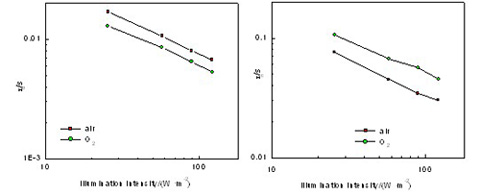| [1] Oregan, B.; Gratzel, M. Nature 1991, 353, 737. [2] Kou, D. X.; Liu, W. Q.; Hu, L. H.; Huang, Y.; Dai, S. Y.; Jiang, N. Q. Acta Phys. Sinica 2010, 59, 5857. (寇东星, 刘伟庆, 胡林华, 黄阳, 戴松元, 姜年权, 物理学报, 2010, 59, 5857.) [3] Chen, C. Y.; Wang, M. K.; Li, J. Y.; Pootrakulchote, N.; Alibabaei, L.; Ngoc-le, C. H.; Decoppet, J. D.; Tsai, J. H.; Gratzel, C.; Wu, C. G.; Zakeeruddin, S. M.; Gratzel, M. ACS Nano 2009, 3, 3103. [4] Luo, Y. H.; Li, D. M.; Meng, Q. B. Adv. Mater. 2009, 21, 4647. [5] Yella, A.; Lee, H. W.; Tsao, H. N.; Yi, C. Y.; Chandiran, A. K.; Nazeeruddin, M. K.; Diau, E. W. G.; Yeh, C. Y.; Zakeeruddin, S. M.; Gratzel, M. Science 2011, 334, 629. [6] Li, J.; Kong, F. T.; Zhang, C. N.; Liu, W. Q.; Dai, S. Y. Acta Chim. Sinica 2010, 68, 1357. (李洁, 孔凡太, 张昌能, 刘伟庆, 戴松元, 化学学报, 2010, 68, 1357.) [7] Huang, X. W.; Deng, J. Y.; Xu, L.; Shen, P.; Zhao, B.; Tan, S. T. Acta Chim. Sinica 2012, 70, 1604. (黄先威, 邓继勇, 许律, 沈平, 赵斌, 谭松庭, 化学学报, 2012, 70, 1604.) [8] Guo, L.; Pan, X.; Wang, M.; Kou, D. X.; Cai, M.; Zhang, C. N.; Dai, S. Y. Acta Chim. Sinica 2011, 69, 767. (郭磊, 潘旭, 王猛, 寇东星, 蔡墨朗, 张昌能, 戴松元, 化学学报, 2011, 69, 767.) [9] Peter, L. M. Phys. Chem. Chem. Phys. 2007, 9, 2630. [10] Zhu, K.; Schiff, E. A.; Park, N. G.; van de Lagemaat, J.; Frank, A. J. Appl. Phys. Lett. 2002, 80, 685. [11] van de Lagemaat, J.; Frank, A. J. J. Phys. Chem. B 2000, 104, 4292. [12] Hagfeldt, A.; Gratzel, M. Chem. Rev. 1995, 95, 49. [13] Hagfeldt, A.; Gratzel, M. Acc. Chem. Res. 2000, 33, 269. [14] Zhu, K.; Kopidakis, N.; Neale, N. R.; van de Lagemaat, J.; Frank, A. J. J. Phys. Chem. B 2006, 110, 25174. [15] Nakamura, I.; Negishi, N.; Kutsuna, S.; Ihara, T.; Sugihara, S.; Takeuchi, E. J. Mol. Catal. A-Chem. 2000, 161, 205. [16] Wu, N. L.; Lee, M. S.; Pon, Z. J.; Hsu, J. Z. J. Photochem. Photobiol. A-Chem. 2004, 163, 277. [17] Chen, C. M.; Hsu, Y. C.; Cherng, S. J. J. Alloys Compd. 2011, 509, 872. [18] Lee, S.; Noh, J. H.; Bae, S. T.; Cho, I. S.; Kim, J. Y.; Shin, H.; Lee, J. K.; Jung, H. S.; Hong, K. S. J. Phys. Chem. C 2009, 113, 7443. [19] Lee, S.; Jun, Y.; Kim, K. J.; Kim, D. Sol. Energy Mater. Sol. Cells 2001, 65, 193. [20] Schlichthorl, G.; Huang, S. Y.; Sprague, J.; Frank, A. J. J. Phys. Chem. B 1997, 101, 8141. [21] Lin, H.; Liu, Y. Z.; Liu, C. J.; Li, X.; Shen, H. P.; Zhang, J.; Ma, T. L.; Li, J. B. J. Electroanal. Chem. 2011, 653, 81. [22] Edvinsson, T.; Pschirer, N.; Schoneboom, J.; Eickemeyer, F.; Boschloo, G.; Hagfeldt, A. Chem. Phys. 2009, 357, 124. [23] O'Regan, B. C.; Durrant, J. R.; Sommeling, P. M.; Bakker, N. J. J. Phy. Chem. C 2007, 111, 14001. [24] Gregg, B. A.; Chen, S. G.; Ferrere, S. J. Phys. Chem. B 2003, 107, 3019. [25] Fisher, A. C.; Peter, L. M.; Ponomarev, E. A.; Walker, A. B.; Wijayantha, K. G. U. J. Phys. Chem. B 2000, 104, 949. [26] Fabregat-Santiago, F.; Bisquert, J.; Garcia-Belmonte, G.; Boschloo, G.; Hagfeldt, A. Sol. Energy Mater. Sol. Cells 2005, 87, 117. [27] Park, J. H.; Kim, J. H.; Choi, C. J.; Kim, H.; Ahn, K. S. Mol. Cryst. Liq. Cryst. 2012, 567, 19. [28] Zhu, K.; Neale, N. R.; Miedaner, A.; Frank, A. J. Nano Lett. 2007, 7, 69. [29] Li, C. H.; Luo, Y. H.; Guo, X. Z.; Li, D. M.; Mi, J. L.; So, L.; Hald, P.; Meng, Q. B.; Iversen, B. B. J. Solid State Chem. 2012, 196, 504. [30] Hu, L. H.; Dai, S. Y.; Wang, K. J. Acta Phys. Sinica 2005, 54, 1914. (胡林华, 戴松元, 王孔嘉, 物理学报, 2005, 54, 1914.)Hu, L. H.; Dai, S. Y.; Weng, J.; Xiao, S. F.; Sui, Y. F.; Huang, Y.; Chen, S. H.; Kong, F. T.; Pan, X.; Liang, L. Y.; Wang, K. J. J. Phys. Chem. B 2007, 111, 358. |
